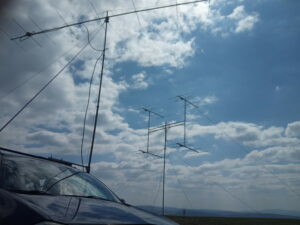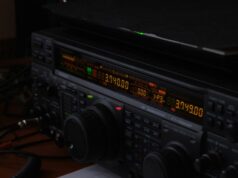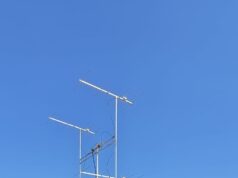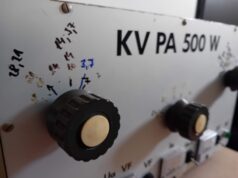You can catch up to twenty minutes in a one hundred and eighty-minute race like the VKVPA? And why it was necessary to make up for the missing time?
I had several news ready for the April round: SDR spectroscopy with R2CW transceiver, which would appear on the display of the mobile phone, output stage with 4CX250b (RE025XA) and square yagi antennas DK7ZB. In the end, it was improvisation. With a delay.
You will read:
TIP how to extend the display of a laptop or computer by a second monitor
It is possible to use the application SpaceDesk The mobile phone holder can be formed from a plastic credit card. The bending line can be heated above the body of the micro-solder
Why 4 x 5 elements DK7ZB yagi?
I prefer to transport the antennas in the car with the rear seats folded down. So if I fit in the length 1,5 meters, I can transport the whole antenna without disassembly. An antenna with such a length from DK7ZB has 5 elements and a profit of approx. 8,4 dBd. The impedance is 50 Ohm.

The second advantage is, that the H-square for the squares of these antennas has dimensions 2 x 2 metre, which is advantageous in meter sales because there is no waste. At the same time, I can also transport such parts inside the car.
Such shorter antennas are usually mounted on top of each other. However, the simulations show, that such antennas need a relatively high mast. It is logical - at a 10m high mast, the top antenna is 10m high, lower in 4m, which is a significant difference. The lower antenna will therefore be in a different electromagnetic field than the upper one. At the same time, the 10m mast is also not among the lowest.

In the H-arrangement, the difference in the electromagnetic field of the antennas is therefore smaller. Simulation result in MMANA speaks, that this configuration with a mast of 5m (therefore antennas in 4m and 6m) gives a profit 21,73 dBi. Mentioned 10m mast with antennas above it has 21,28 dBi.
Preparatory work of VKVPA
Daylight saving time means, that VKVPA begins at 10 a.m. local time. I still come to the field relatively early and 8 element DK7ZB I bet fast. For squares 5 element DK7ZB I have to prepare a heel, rotator, anchor pins, fold H-čko, connect antennas to it, combiner and cables. first place, where I put my heel turned out to be inappropriate. But I only found out when I hammered in the anchor pins and prepared the anchors. I'm moving it a meter further.
The individual cables from the antennas are a bit laborious. There were four WiFi pigtails in the domestic stock with N connectors made of RF-240 coaxial with a length of 5 meters. That's a little more than necessary. This makes the cables more difficult to work with and the excess is twisted at the combiner.

Lifting 4 x 5 elements DK7ZB yagi goes playfully with the help of a pulley. Just a short tightening of the anchor ropes and I'm starting to prepare a setup for broadcasting.
I connect the SDR clone RSP1 to the R2CW and activate the second monitor via the Spacedesk application. I also switch on the output stage. It's not quite finished yet, but only anode voltage measurements are missing. Something is wrong, the switch to transmit switches the relay, but performance doesn't work out. VKVPA is already starting.
I'm replacing the transceiver with a Kenwood TR-751E, I'm disconnecting SDR, output stage. Because I don't have a good antenna switch, so I connect an old switch with PL-connectors and PL-N reducers. Until it manages to change that, it will take a number of minutes.
Broadcasting in VKVPA
So I'm finally starting and finding out VKVPA, that the rotator does not rotate the square 5 element DK7ZB yagi antennas. It seems to be heard, that the controller is working. The antennas therefore remain fixed in azimuth about 210 degrees.
However, as a fourth connection, I am doing IU4CHE, that's at San Marine. And only at 25W and completely playful. On the square, of course. By comparing with 8 element DK7ZB yagi shows a noticeable difference in favor of square antennas, which is additionally connected by a longer and worse coaxial cable. I do antenna comparisons several times in the contest and it is also an advantage to be able to quickly switch antennas if they are in different directions..

And then I made some connections and VKVPA ended. Too bad the missing time, a better result would certainly work. It's at the end 65 QSOs to 17 locator squares.

The lesson - reliability is key when broadcasting from a transitional site. I promise, that next time it will be better prepared!










